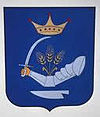
Kaposvár is a city in the southwestern part of Hungary, south from the Lake Balaton. It is one of the leading cities of Transdanubia and it is the capital of Somogy County as well as the seat of Kaposvár District and of the Roman Catholic Diocese of Kaposvár.

Somogy is an administrative county in present Hungary, and also in the former Kingdom of Hungary.
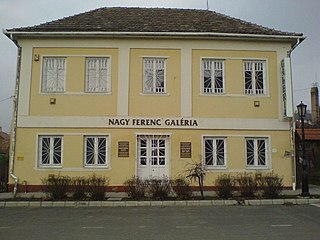
Tab is a town in Somogy County, Hungary and the seat of Tab District. It is situated approximately 175 km South West of Budapest and 22 km from Lake Balaton.
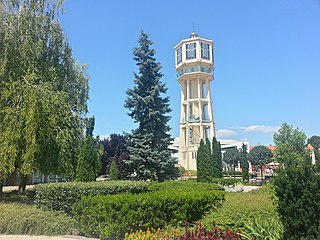
Siófok is a town in Somogy County, Hungary on the southern bank of Lake Balaton. It is the second largest municipality in Somogy County and the seat of Siófok District. It covers an area of about 124.66 km2 between Lake Balaton, the Mezőföld and the Outer Somogy-Hills. Lying at the firth of the Sió Channel, it serves as the most important logistic station for goods between Lake Balaton and the River Danube.

Békés, is an administrative division in south-eastern Hungary, on the border with Romania. It shares borders with the Hungarian counties Csongrád, Jász-Nagykun-Szolnok, and Hajdú-Bihar. The capital of Békés county is Békéscsaba. The county is also part of the Danube-Kris-Mures-Tisa euroregion.

Csurgó is a town in Somogy county, Hungary and the seat of Csurgó District.

The Black Army, also called the Black Legion/Regiment – possibly after their black armor panoply – is a common name given to the military forces serving under the reign of King Matthias Corvinus of Hungary. The ancestor and core of this early standing mercenary army appeared in the era of his father John Hunyadi in the early 1440s. The idea of the professional standing mercenary army came from Matthias' juvenile readings about the life of Julius Caesar.
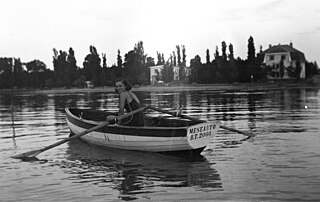
Balatonszabadi is a village in Somogy county, Hungary.

Kapoly is a village in Somogy county, Hungary. Political leader János Kádár originates from the village, his childhood was spent in Kapoly.

Bálványos is a village in Somogy County, Hungary.

Gadács is a village in Somogy county, Hungary.
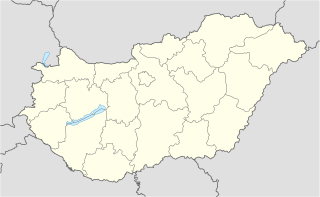
Kötcse is a village in Somogy county, Hungary. The village is known for being a summer resort because of its proximity to Lake Balaton and its good weather conditions. Several houses are weekend houses and have no permanent residents. Among others former Prime Minister and leader of the DK political party, Ferenc Gyurcsány spends his holidays here with his family. Since 2004 the settlement and the Dobozy Chateau hosts the Polgári Piknik meeting organized by the Polgári Magyarországért Alapítvány of the Christian-conservative elite. Leading figures of Hungarian life - politicians, thinkers, scientists, business people - gather together in the village for the event.
Hungarian Slovenes are an autochthonous ethnic and linguistic Slovene minority living in Hungary. The largest groups are the Rába Slovenes in the Rába Valley in western Hungary between the town of Szentgotthárd and the borders with Slovenia and Austria. They speak the Prekmurje Slovene dialect. Outside the Rába Valley, Slovenes mainly live in the Szombathely region and in Budapest.

Ferenc Keresztes-Fischer was a Hungarian lawyer and politician. He was an advisor of the Pécsi Takarékpénztár Rt. / Pécs Savings Bank Corp. He was the prefect of Baranya County 1921–1931, and the prefect of Somogy County 1925–1931 and was appointed as Interior Minister of Hungary twice; between 1931–1935 and 1938–1944. He controlled the police terror against both the left and right wing political movements. In a secret directive he ordered the collection of Press articles.(?) On 12 September 1938, he allowed the OMIKE to increase its activities. During the Second World War he was an active supporter of the Regent, Admiral Miklós Horthy. After the death of Pál Teleki Keresztes-Fischer became acting Prime Minister on that day. One year later, On March 7, 1942, Bárdossy the prime minister was forced to resign suddenly by Regent Horthy and as Minister of the Interior, Ferenc-Keresztes was the interim Prime Minister until 9 March, when Miklós Kállay was appointed to this position.
The Prekmurje Slovenes are Slovenes from Prekmurje in Slovenia and Vendvidék and Somogy in Hungary. The Prekmurje Slovenes speak the Prekmurje Slovene and have a common culture. The Hungarian Slovenes (Porabski Slovenci) and Somogy Slovenes also speak the Prekmurje Slovene.
Szulimán is a village in Baranya county, Hungary.

Dr. Sándor Kozma de Leveld was a Hungarian politician and jurist, who served as the first Crown Prosecutor of Hungary from 1872 to 1896.

Felsőtárkány is a municipality in the Eger Subregion of Heves county, Hungary.

Dr. István Farkas de Boldogfa was a Hungarian nobleman, jurist of the Kingdom of Hungary, supreme chief magistrate of district of Sümeg (főszolgabíró) in the county of Zala.
